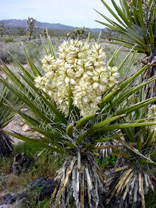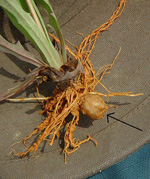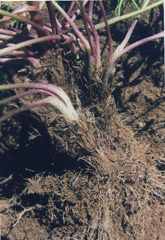 |
Amole (Yucca Root): Amole's present popularity may be accountable to it being New Mexico's state plant. It was popular with many Indian tribes years ago for its wide use in shampoos and detergents. The bark of this plant is grated and boiled to make a wash for cradle cap and dandruff. Because Amole contains steroids, it is used to reduce pain and inflammation due to arthritis and rheumatism. For these symptoms, the inner pith of the bark is used to make an herbal tea remedy. |
Ginger (Zingiber Officinale ). Ginger is another great example of how a plant can be used as a food, spice or medicine. It has been used to treat nausea, motion sickness and vomiting. Ginger has a long history of use for all types of digestive upset and can be helpful to increase appetite.
Cachana (Blazing Star): Cachana has long been used in New Mexico as a talisman against witchcraft. Indians and Hispanics believe that if the root is displayed on the body it will prevent them from being the victims of evil spells and curses. Specifically, Cachana is considered to be sacred protection against the much feared spell "ojo" that is cast upon babies admired by someone with the "evil eye". Besides it protection powers, Cachana root can be used to make a tea that relieves throat hoarseness and soreness due to laryngitis. To relieve headaches and nosebleeds, the root is burned and used as a smoke inhalant.
 |
Chicoria (Dandelion Root): Quite surprisingly, the common dandelion serves many medicinal purposes. This yellow flower is used as an effective blood builder and purifier. Chicoria tea is recommended for anemia or liver disorders. To make an herbal tea remedy, the roots are steeped in hot water. The infusion is taken hot or cold. This tea is traditionally drunk to dissolve urinary stones and to aid in kidney infections. |
Contrayerba (Caltrop) Contrayerba is a trailing, slightly hairy herb with axillary orange flowers, opposite leaves, and a spiny fruit, which grows on the dry plains in the lower and upper Sonoran zones of New Mexico. It is not the same plant that was formerly called contrayerba and used by the Spaniards in Peru as an antidote against poison. Spanish New Mexican say that the powdered caltrop's roots, soaked in warm water will make a good wash for sore eyes and swollen gums, and if taken as a tea it's an excellent remedy for fever, stomach trouble, and dysentery. If mixed in equal parts with osha and copalquin and boiled, the ensuing compound tea will relieve diarrhea. The Indians in San Ildefonso Pueblo chew the leaves and put them on sores or swellings and also drink a decoction of the roots for diarrhea.
Flor De San Juan (Evening Primrose): Spanish Americans use this herb as a diuretic to cleanse the urinary tract. The root, leaves and tops of the plant are all used in various herbal remedies. The roots are chopped and boiled wit honey to make a cough syrup. The leaves and tops are used to make a laxative tea for constipation. Studies done on this herb have shown its use to be beneficial in treating PMS.
Inmortal (Creeping Milkweed): Inmortal was named appropriately by Hispanic Americans due to its ability to re-grow, without interruption, even if only a small portion of the root remains in the ground. Traditionally, this herb is used in tea form during and after childbirth to help stimulate uterine contractions and promote internal healing. For lactating mothers, Inmortal speeds the changeover from colostrum to milk production. The herb is also taken for shortness of breath, as a snuff for sinus congestion and as a preventative against disease.
Malva (Mallow Plant): It was once believed that Malva was a preventative against all diseases. A decoction of this plant is used as a wash for diaper or heat rash and for bee or wasp stings. The roots and leaves make a tea that is taken to loosen a tight, hoarse cough and to reduce a high fever. In New Mexico, Malva tea is combined with raisins to make a remedy that is given to new mothers. This remedy is believed to help expel the remaining afterbirth and to increase the quality and flow of the milk supply. Malva is an excellent demulcent.
 |
Osha: Osha is quite possibly the most well known herb in New Mexico, used by generation after generation for basically any problem. The root is the most potent part of this plant, and is therefore, the most widely used for remedies. Chewing the root raw soothes sore throats and gum irritation. A tea of the boiled root loosens phlegm and combats viral colds and flu. Powdered Osha root is used to make a soothing cough syrup. Years ago, Penitentes of New Mexico claimed that an ointment made with Osha would heal all wounds to the skin. Traditionally, Osha has been declared for its powers as a talisman (worn tied around the ankle or pinned to clothing) to ward rattlesnakes, evil spirits, and witchcraft curses. |